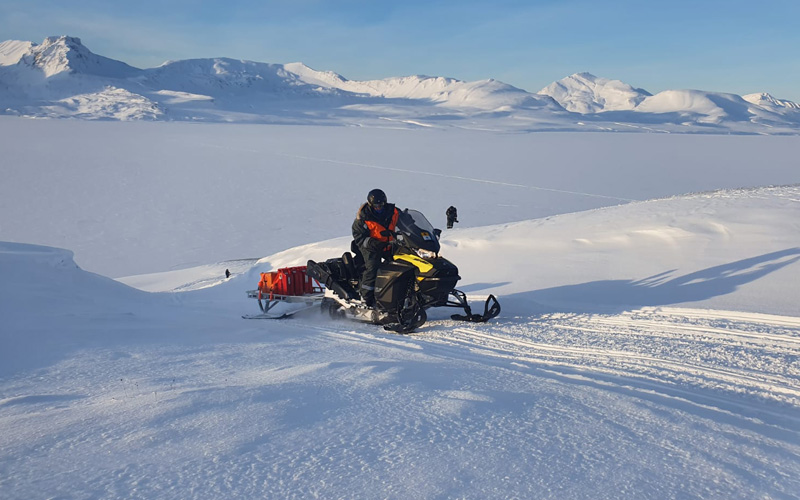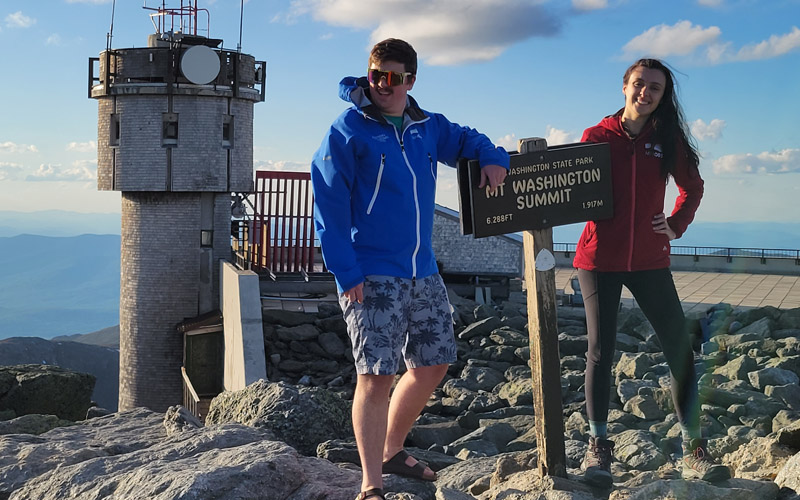Septem-burrr!
Septem-burrr!
2022-09-25 20:07:59.000 – Ryan Knapp, Weather Observer/Staff Meteorologist
 Tip Top House and the summit sign surrounded by the fresh September snow and ice at sunrise on 24 Sept 2022
Tip Top House and the summit sign surrounded by the fresh September snow and ice at sunrise on 24 Sept 2022 Mt Clay, Mt Jefferson, Mt Adams, and Mt Madison with recent snow/ice on Mt Washington at sunrise 25 September 2022
Mt Clay, Mt Jefferson, Mt Adams, and Mt Madison with recent snow/ice on Mt Washington at sunrise 25 September 2022Ryan Knapp, Weather Observer/Staff Meteorologist







 This plate tectonic cross-section depicts the forming of the Presidential Mountains starting ~420 million years ago with the deposition of marine sediment (Eusden 2010).
This plate tectonic cross-section depicts the forming of the Presidential Mountains starting ~420 million years ago with the deposition of marine sediment (Eusden 2010). The view of the ancient Presidential Range, ~400 million years ago, as viewed from the west. This is compared to today’s skyline (Eusden 2010).
The view of the ancient Presidential Range, ~400 million years ago, as viewed from the west. This is compared to today’s skyline (Eusden 2010). Timeline of mountain building and erosion events that caused the creation of the Presidential Mountain Range (Eusden 2010).
Timeline of mountain building and erosion events that caused the creation of the Presidential Mountain Range (Eusden 2010).

 Clouds forming on Tuckerman Ravine.
Clouds forming on Tuckerman Ravine. My first time experiencing rime ice.
My first time experiencing rime ice.  Summit exposed between layers of clouds.
Summit exposed between layers of clouds.  Beautiful colors at sunset.
Beautiful colors at sunset. 

 A tide pool near Bamfield, BC, Canada, showing the biodiversity of intertidal life. Ulva fenestrata is the grass-green seaweed. Giant green anemones, some with shell fragments stuck to them, are visible in the middle of the image.
A tide pool near Bamfield, BC, Canada, showing the biodiversity of intertidal life. Ulva fenestrata is the grass-green seaweed. Giant green anemones, some with shell fragments stuck to them, are visible in the middle of the image. The Northern Lights visible from the summit on July 4, 2022.
The Northern Lights visible from the summit on July 4, 2022. Naomi Lubkin, left, and Larz von Huene are shown around tree line on Mount Washington this summer.
Naomi Lubkin, left, and Larz von Huene are shown around tree line on Mount Washington this summer.


 Alexis George, left, performing maintenance on a Mt. Rogers weather station with the Meteorology department at Virginia Tech.
Alexis George, left, performing maintenance on a Mt. Rogers weather station with the Meteorology department at Virginia Tech. Snow and ice coated Mount Washington on June 19.
Snow and ice coated Mount Washington on June 19. Rime ice formation on the observation tower.
Rime ice formation on the observation tower. Alexis at the summit.
Alexis at the summit. 
 Pack fitting was offered at the EMS and Backpacker Magazine booths.
Pack fitting was offered at the EMS and Backpacker Magazine booths. EMS field experts get ready for the expo to open.
EMS field experts get ready for the expo to open. Seek the Peak hikers enjoy views from the Observation tower during a tour of our summit weather station.
Seek the Peak hikers enjoy views from the Observation tower during a tour of our summit weather station. Seek the Peak team ‘The Seekers’ are shown atop Blueberry Mountain.
Seek the Peak team ‘The Seekers’ are shown atop Blueberry Mountain. 
 Carrie Slife of MWOBS visits with Mel Elam and her cat Flokie at Tuckerman Brewing Co. Friday night at the Seek the Peak kick-off party. Mel and Flokie have summited all of New Hampshire’s 4,000 footers together.
Carrie Slife of MWOBS visits with Mel Elam and her cat Flokie at Tuckerman Brewing Co. Friday night at the Seek the Peak kick-off party. Mel and Flokie have summited all of New Hampshire’s 4,000 footers together. Seek the Peak hikers visit the Backpacker Get Out More Tour booth. EMS photo.
Seek the Peak hikers visit the Backpacker Get Out More Tour booth. EMS photo. Randy Propster of Backpacker helps a visitor with pack fitting.
Randy Propster of Backpacker helps a visitor with pack fitting.  The Bear Mountain Band performs at the expo.
The Bear Mountain Band performs at the expo. Cotopaxi brought tons of color to the expo. EMS photo.
Cotopaxi brought tons of color to the expo. EMS photo. The gear giveaway.
The gear giveaway. Hyperlite Mountain Gear was one of our 2022 sponsors.
Hyperlite Mountain Gear was one of our 2022 sponsors. Granite Backcountry Alliance was one of our sponsors. EMS photo.
Granite Backcountry Alliance was one of our sponsors. EMS photo. Visitors learn about our weather and climate work in the White Mountains at the MWOBS booth.
Visitors learn about our weather and climate work in the White Mountains at the MWOBS booth. Randy Propster of Backpacker and Carrie Slife of MWOBS pull raffle tickets as the gear giveaway begins.
Randy Propster of Backpacker and Carrie Slife of MWOBS pull raffle tickets as the gear giveaway begins. A MWOBS parking volunteer greets the camera enthusiastically by the food trucks.
A MWOBS parking volunteer greets the camera enthusiastically by the food trucks. An expo visitor enjoys music performed by the Bear Mountain Band. EMS photo.
An expo visitor enjoys music performed by the Bear Mountain Band. EMS photo.

 Hayden Pearson driving to fieldwork in central Spitsbergen. Image taken by fellow researcher Cody Barnett.
Hayden Pearson driving to fieldwork in central Spitsbergen. Image taken by fellow researcher Cody Barnett. Ski touring in Svalbard. Image taken by fellow researcher Joe Buckby.
Ski touring in Svalbard. Image taken by fellow researcher Joe Buckby. Hayden Pearson and Jackie Bellefontaine, both Weather Observers/Education Specialists (UMaine alums taking over the summit!).
Hayden Pearson and Jackie Bellefontaine, both Weather Observers/Education Specialists (UMaine alums taking over the summit!).